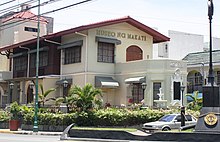The University of Makati, a public, non-profit university, is the city's flagship university. Other institutions of higher education include the Asian Institute of Management (AIM), the Ateneo Professional Schools, Australian Catholic University - Manila Program, the Mapúa Institute of Technology, Lyceum of the Philippines University-Makati, Centro Escolar University Makati, Far Eastern University-Makati, iAcademy, Asian Seminary of Christian Ministries (ASCM), Don Bosco Technical Institute, Makati, Assumption College San Lorenzo, Colegio San Agustin, Saint Paul College of Makati, Our Lady of Guadalupe Minor Seminary, Asia Pacific College, Colegio de Santa Rosa Makati Assumption College, AMA Colleges Makati, Inc. among others.
Historical sites[edit]
Magallanes Interchange[edit]
The Magallanes Interchange, which was conceived in 1969 and opened in 1975, was one of the first structures of its kind in the country.
Hagdang Bato[edit]
This part of Namayan was sacred to early Tagalogs. Hagdang bató (see photo) is mentioned in chapter sixty-one of José Rizal's first novel, Noli Me Tángere, and chapter three of his second novel, El Filibusterismo. During the Revolution on 10 June 1897, Gen. Emilio Aguinaldo and about five hundred soldiers crossed the Pasig River at Hagdang bató during the march to Biac-na-bató in Bulacán.
Museo ng Makati[edit]
Located along J.P. Rizal St., the Museo ng Makati is housed in an old building, which was built in 1918 and has been used as Makati's town hall from 1918 to 1961. The museum keeps the records of Makati's history through a collection of rare photographs, murals, and dioramas. It also contains artifacts, such as the fossils of pre-historic animals and earthenware.[25]
The museum's architecture is a classic "Bahay na Bato", made of masonry at the ground floor and wood at the upper level. In 1934, during the reign of Mayor Nicanor Garcia, the structure was rebuilt using concrete materials. In 1958, while it was still used as a town hall, then Mayor Maximo Estrella had it renovated. In 1961, when the local government of Makati moved its office to its current site, the old town hall was used as the Municipal Library.[citation needed]
But when the library was transferred to the new city hall compound, the old town hall was used as the Philippine Eye and Ear Infirmary. During the term of Mayor Jejomar Binay, the structure was converted into a museum through City Ordinance No. 186 that was enacted in March 1990.[26]
Nuestra Señora de Gracia Church[edit]
The Nuestra Señora de Gracia Church is a baroque Roman Catholic church which was established in 1601 by Augustinian fathers.[27] Its original architecture is a blend of the late Spanish Renaissance and early Baroque design. The touch of the Renaissance period is found in the main entrance with rose window and simple Doric columns. The interiors and the window details, meanwhile, have influences of Baroque architecture. The floor plan, on the other hand, is Romanesque.[27] During the Seven Years' War, this church was raided by the British, an event which marks the first time that Makati was affected by a global conflict. The church was damaged due to an earthquake in 1880 and in 1898 during the early skirmishes between American and Filipino troops.[28]
The Nuestra Señora de Gracia Church is one of the most popular wedding venues in Metro Manila.[29][30]
Saints Peter and Paul Church[edit]
Tucked in D.M. Rivera St. and surrounded by skyscrapers and residential areas, Sts. Peter and Paul Church is the oldest church in Makati, which was opened to the faithful in 1620.[31] It was built by Jesuit priest Rev. Pedro de los Montes at a site named Buenavista through the generous donation of Capt. Pedro de Britto in 1607.[32]
The church's architectural design is a rectangular nave with apse and sacristy, which is a usual design for colonial mission churches.[33] The façade is composed of three-tiered papal and keys, symbols of the Papacy, which was first occupied by St. Peter, one of the patron saints of the parish.[34]
Santa Ana Cabaret[edit]
This twentieth-century nightclub (photos), which was owned by an American citizen and later his son, was once advertised as being the largest cabaret in the world. It opened in Tejeros in 1921 and was in business until 1970, when a typhoon destroyed it. Famous patrons included Cwlth. Pres. Manuel Quezon, US Gov.-Gen. Francis Harrison, and US Gen. Douglas MacArthur. It is also said that the UK's Prince of Wales once visited it. During World War II it was converted into a garment factory, producing shirts and military uniforms for the Japanese. After the Americans returned to Makati in February 1945, they converted their famous dance hall into a temporary medical facility. It was the forerunner of fashionable discos of the eighties and nineties, such as Manila' classy Stargazer, as well as Makati's Euphoria, Faces, and Mars. Its modern counterpart is the Valkyrie Nightclub in Taguig.


No comments:
Post a Comment